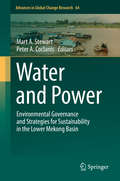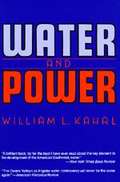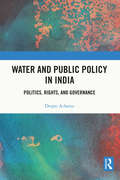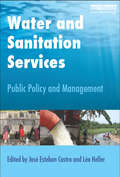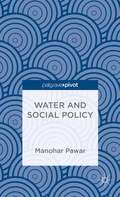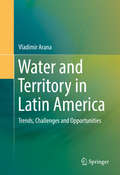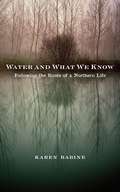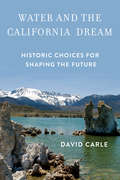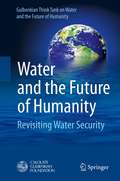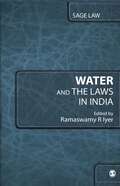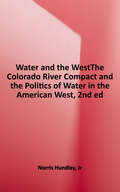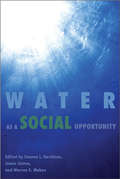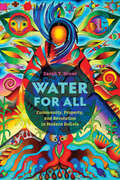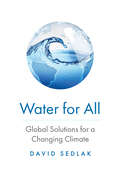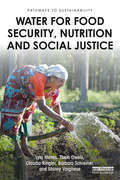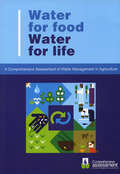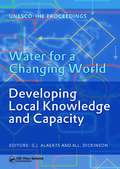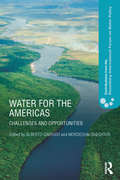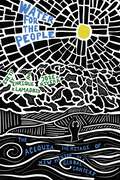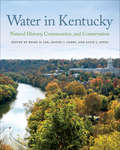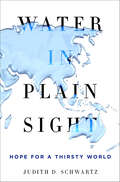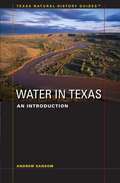- Table View
- List View
Water and Power: Environmental Governance And Strategies For Sustainability In The Lower Mekong Basin (Advances In Global Change Research #64)
by Peter A. Coclanis Mart A. StewartThis book brings together a talented international group of scholars, policy practitioners, and NGO professionals that explores a range of issues relating to environmental, developmental, and governing challenges on the Mekong, one of the world’s greatest rivers and, alas, one of the most endangered. <p><p> The book is divided into three sections devoted in turn to historical perspectives on the Lower Mekong Basin. Issues relate to livelihood strategies, environmental threats, and adaptation strategies; and various aspects of river governance, with individual authors treating questions of governance at different levels of refraction and in different registers. The result is a fresh and innovative collection of essays, which, taken together, provide much-needed new perspectives on some of the most important and seemingly intractable environmental and development issues in contemporary Asia.
Water and Power: The Conflict over Los Angeles' Water Supply in the Owens Valley
by William L. KahrlThis book gives a historical account of the exploitation of water resources of California and the West with maps and documents.
Water and Public Policy in India: Politics, Rights, and Governance
by Deepti AcharyaThis book explores the conceptual and theoretical frameworks of Right to Water and analyzes its values in the context of water policy frameworks of the union governments in India. It uses a qualitative approach and combines critical hermeneutics with critical content analysis to introduce a new water policy framework. The volume maps the complex argumentative narrations which have emerged and evolved in the idea of Right to Water and traces the various contours and the nature of water policy texts in independent India. The book argues that the idea of Right to Water has emerged, evolved and is being argued through theoretical arguments and is shaped with the help of institutional arrangements developed at the international, regional, and national levels. Finally, the book underlines that India’s national water policies drafted respectively in 1987, 2002 and 2012, are ideal but are not embracing the values and elements of Right to Water. The volume will be of critical importance to scholars and researchers of public policy, environment, especially water policy, law, and South Asian studies.
Water and Ritual: The Rise and Fall of Classic Maya Rulers
by Lisa J. LuceroIn the southern Maya lowlands, rainfall provided the primary and, in some areas, the only source of water for people and crops. Classic Maya kings sponsored elaborate public rituals that affirmed their close ties to the supernatural world and their ability to intercede with deities and ancestors to ensure an adequate amount of rain, which was then stored to provide water during the four-to-five-month dry season. As long as the rains came, Maya kings supplied their subjects with water and exacted tribute in labor and goods in return. But when the rains failed at the end of the Classic period (AD 850-950), the Maya rulers lost both their claim to supernatural power and their temporal authority. Maya commoners continued to supplicate gods and ancestors for rain in household rituals, but they stopped paying tribute to rulers whom the gods had forsaken.
Water and Sanitation Services: Public Policy and Management
by Jos LSubstantially reducing the number of human beings who lack access to clean water and safe sanitation is one of the key Millennium Development Goals. This book argues and demonstrates that this can only be achieved by a better integration of the technical and social science approaches in the search for improved organization and delivery of these essential services. It presents a historical analysis of the development of water and sanitation services in both developed and developing countries, which provides valuable lessons for overcoming the obstacles facing the universalization of these services. Among the key lessons emerging from the historical analysis are the organizational and institutional diversity characterizing the development of water and sanitation internationally, and the central role played by the public sector, particularly local authorities, in such development. It also explores the historical role played by cooperatives and other non-profit institutions in reaching rural and peri-urban areas, as well as the emergence of new forms of organization and provision, particularly in poor countries, where aid and development agencies have been promoting the self-organization of water systems by local communities. The book provides a critical exploration of these different institutional options, including the interaction between the public and private sectors, and the irreplaceable role of public funding as a condition for success. The book is divided into two parts: the first reviews theoretical and conceptual issues such as the political economy of water services, financing, the interfaces between water and sanitation services and public health, and the systemic conditions that influence the provision of these services, including the diversity of organizational and institutional options characterizing the governance and management of water and sanitation services. The second section presents a number of country or regional case studies, each one chosen to highlight a particular problem, approach or strategy. These case studies are drawn from Africa, the Americas, Asia and Europe, covering a wide range of socio-economic and political contexts. The book will be of great interest to advanced students, researchers, professionals and NGOs in many disciplines, including public policy and planning, environmental sciences, environmental sociology, history of technology, civil and environmental engineering, public health and development studies.
Water and Social Policy
by Manohar PawarManohar Pawar discusses the relevance and importance of social policy for water issues. By analysing several interrelated perspectives on water, he suggests core values as bases for formulating and implementing social policies so as to provide universal free access to safe drinking water for all, particularly for the most poor and disadvantaged.
Water and Territory in Latin America
by Vladimir AranaThis book focuses in the current situation of water resources, water supply and sanitation, and population movement in Latin America. It identifies new phenomena and challenges that will put more pressure on water resources in the near future and that will create important socioeconomic constraints in population and their governments. This volume offers an evaluation of water resources availability and consumption, water supply and sanitation shortages, management models and population growth and territory occupation trends in eighteen Latin American countries. Also a set of recommendations, policy proposals and projects is outlined.
Water and What We Know: Following the Roots of a Northern Life
by Karen Babine2016 Minnesota Book Award Winner for Memoir & Creative Nonfiction Consider your place, the place where you feel the most at home: a tree-lined lake, a bean field planted on stolen land, a rig drilling the golden prairie, city streets alive with energy. Written in the language of the northern landscape of experience, Karen Babine explores the meaning of being in your place on a particular day.In essays that travel from the wildness of Lake Superior to the order of an apple orchard, Babine traces an ethic of place, a way to understand the essence of inhabiting a place deeply rooted in personal stories. She takes us from moments of reflection, through the pages of her Minnesota family&’s history, to the drama of the land and the shaping of the earth. From the Mississippi&’s Headwaters in Itasca State Park—its name from veritas caput, or &“true head&”—she explores the desire that drives the idea of the North. The bite of a Honeycrisp apple grown in Ohio returns her to her origin in Minnesota and to pie-making lessons in her Gram&’s kitchen. In the Deadwood, South Dakota, of her great-great-grandfather, briefly police chief; in the translation of her ancestors from Swedish to Minnesotan; on the outer edge of the New Madrid Fault in Nebraska; through the flatlands along I-90; at the foot of Mount St. Helens: Babine pursues what the Irish call dinnseanchas, place-lore. How, she asks, does land determine what kind of people grow in that soil? And through it all runs water, carrying a birch bark canoe with a bullet hole and a bloodstain, roaring over the Edmund Fitzgerald, flooding the Red River Valley, carving the glaciated land along with historical memory.As she searches out the stories that water has written upon human consciousness, Babine reveals again and again what their poignancy tells us about our place and what it means to be here.
Water and the California Dream: Historic Choices for Shaping the Future (A\sierra Club Books Publication Ser.)
by David CarleImported water has transformed the Golden State's environment and quality of life. Land ownership patterns and real estate boosterism dramatically altered both urban and rural communities across the entire state. The key has been redirecting water from the Eastern Sierra, the Colorado River, and Northern California rivers. "Whoever brings the water, brings the people," wrote engineer William Mullholland, whose leadership began the process of water irrigating unlimited growth. Using first-person voices of Californians to reveal the resulting changes, Carle concludes that now is the time to stop drowning the California Dream.With extensive use of oral histories, contemporary newspaper articles and autobiographies, Carle provides a rich exploration of the historic changes in California, as imported water shaped patterns of growth and development. In this thoroughly revised edition, Carle brings that history up to date, as water choices remain the primary tool for shaping California's future. In a land where climate change is exacerbating the challenges of a naturally dry region, the state's damaged environment and reduced quality of life can be corrected, Carle argues, if Californians step out of the historic pattern and embrace limited water supplies as a fact of life.
Water and the Future of Humanity
by Springer International PublishingThis unique, engaging, and highly authoritative volume enlightens readers on changes needed in the way society accesses, provides, and uses water. It further shines a light on changes needed in the way we use food, energy, and other goods and services in relation to water, and offers projections and recommendations, up to 2050, that apply to water access challenges facing the poor and the common misuse of water in industry, agriculture, and municipalities. Written by an unparalleled slate of experts convened by the Calouste Gulbenkian Foundation, the book takes on one of the most critical issues on the planet today. In a frank yet optimistic assessment of major developmental challenges, but also opportunities, facing future generations, the author elucidates linkages between water and a range of other drivers from various disciplinary and stakeholder perspectives. Ultimately portraying the belief that Humanity can harness its visionary abilities, technologies, and economic resources for increased wellbeing and sound stewardship of resources, the book presents an optimistic statement stressing actions scientists, policy makers, and consumers can and must take to meet the water management challenges of a warming planet anticipating nine billion inhabitants by 2050. Gulbenkian Think Tank on Water and the Future of Humanity: Benedito Braga, Pres. World Water Council & Prof. of Civil Engineering, Univ. of São Paulo, Brazil; Colin Chatres, Director General of the International Water Management Institute, Sri Lanka; William J. Cosgrove, Pres. of Ecoconsult Inc. & Senior Adviser for the UN World Water Development Report, Canada; Luis Veiga da Cunha, Prof. Environmental Science and Engineering, Universidade Nova de Lisboa, Portugal; Peter Gleick, Pres. of the Pacific Institute, USA; Pavel Kabat, Director, International Institute for Applied Systems Analysis, Austria; and Prof. & Chair, Earth Systems Science, Wageningen University, The Netherlands; Mohamed Ait Kadi, President of the General Council of Agricultural Development, Morocco; Daniel P. Loucks, Prof. of Civil Engineering, Cornell Univ. USA; Jan Lundqvist, Senior Scientific Advisor, Stockholm International Water Institute, Sweden; Sunita Narain, Director, Center for Science & Environment, New Delhi, India; Jun Xia, Pres. , International Water Resources Association, Chair Prof. & Dean, The Research Institute for Water Security (RIWS), Wuhan University, China.
Water and the Laws in India (SAGE Law)
by Ramaswamy R. IyerLaws relating to water in India have diverse origins, including ancient local customs and the British Common Law. The in-depth chapters in this compendium, written by luminaries from various fields, pertain to issues on water and proceed to a discussion of the legal questions that arise. This volume thus straddles two domains, viz., (i) water-resource policy, management, conservation, conflict-resolution, etc., and (ii) water law. The book also briefly raises and explores the case for a constitutional declaration on water and an overarching national water law. The book is an invaluable resource for policy-makers, planners and administrators concerned with water at the Central, State and local levels; students, academics and practitioners in the domains of water as well as law; and social scientists, NGOs and activists concerned with the various issues discussed in the book. It should be useful as a main or supplementary textbook in universities and research or management institutions where any aspect of water (engineering, ecological, legal, social, economic, management or other) is a subject of study.
Water and the West: The Colorado River Compact and the Politics of Water in the American West
by Norris HundleyBack in print for the first time in over ten years, this classic account of the numerous struggles--national, state, and local--that have occurred over western American water rights since the late 1800s is thoroughly expanded and updated to trace the continuing battles raging over the West's most valuable, and contentious, resource.
Water as a Social Opportunity
by Seanna L. Davidson Jamie Linton Warren E. MabeeOften when water is thought about, the focus is on problems, challenges, and crises. In November 2012, a group of researchers came together at Queen’s University with the idea that it is more illuminating and constructive to think about water as an opportunity. Water as a Social Opportunity conveys the idea that the ways in which society responds to water-related challenges has the potential to yield a variety of positive outcomes not just for water, or the economy, but for society more broadly. Contributors consider water issues across Canada from this original perspective, and suggest this concept as a basis for developing a long-overdue national water strategy in Canada.
Water as a Social Opportunity (Queen's Policy Studies Series)
by Seanna L. Davidson, Jamie Linton and Warren E. MabeeOften when water is thought about, the focus is on problems, challenges, and crises. In November 2012, a group of researchers came together at Queen’s University with the idea that it is more illuminating and constructive to think about water as an opportunity. Water as a Social Opportunity conveys the idea that the ways in which society responds to water-related challenges has the potential to yield a variety of positive outcomes not just for water, or the economy, but for society more broadly. Contributors consider water issues across Canada from this original perspective, and suggest this concept as a basis for developing a long-overdue national water strategy in Canada.
Water for All: Community, Property, and Revolution in Modern Bolivia
by Sarah T. HinesWater for All chronicles how Bolivians democratized water access, focusing on the Cochabamba region, which is known for acute water scarcity and explosive water protests. Sarah T. Hines examines conflict and compromises over water from the 1870s to the 2010s, showing how communities of water users increased supply and extended distribution through collective labor and social struggle. Analyzing a wide variety of sources, from agrarian reform case records to oral history interviews, Hines investigates how water dispossession in the late nineteenth century and reclaimed water access in the twentieth and twenty-first centuries prompted, shaped, and strengthened popular and indigenous social movements. The struggle for democratic control over water culminated in the successful 2000 Water War, a decisive turning point for Bolivian politics. This story offers lessons for contemporary resource management and grassroots movements about how humans can build equitable, democratic, and sustainable resource systems in the Andes, Latin America, and beyond.
Water for All: Global Solutions for a Changing Climate
by David SedlakA fresh look at the world&’s water crises, and the existing and emerging solutions that can be used to solve them It is not your imagination: water crises are more frequent. Our twentieth-century systems for providing the water that grows food, sustains cities, and supports healthy ecosystems are failing to meet the demands of growing population and the challenges brought on by climate change. But the grim news reports—of empty reservoirs, withering crops, failing ecosystems—need not be cause for despair, argues award-winning author David Sedlak. Communities on the front lines of previous water crises have pioneered approaches that are ready to be applied elsewhere. Some have resolved shortages by enhancing water-use efficiency, and others have used moments of crisis to resolve historic disagreements over water rights. Still others have employed treatment technologies that unlock vast quantities of untapped water resources. Sedlak identifies the challenges that society faces, including ineffective policies and outdated infrastructure, and the myriad of tools at our disposal—from emerging technologies in desalination to innovations for recycling wastewater and capturing more of the water that falls on fields and cities. He offers an informed and hopeful approach for rethinking our assumptions about the way that water is managed. With this knowledge we can create a future with clean, abundant, and affordable water for all.
Water for Food Security, Nutrition and Social Justice (Pathways to Sustainability)
by Claudia Ringler Barbara Schreiner Lyla Mehta Theib Oweis Shiney VargheseThis book is the first comprehensive effort to bring together Water, Food Security and Nutrition (FSN) in a way that goes beyond the traditional focus on irrigated agriculture. Apart from looking at the role of water and sanitation for human well-being, it proposes alternative and more locally appropriate ways to address complex water management and governance challenges from the local to global levels against a backdrop of growing uncertainties. The authors challenge mainstream supply-oriented and neo-Malthusian visions that argue for the need to increase the land area under irrigation in order to feed the world’s growing population. Instead, they argue for a reframing of the debate concerning production processes, waste, food consumption and dietary patterns whilst proposing alternative strategies to improve water and land productivity, putting the interests of marginalized and disenfranchized groups upfront. The book highlights how accessing water for FSN can be challenging for small-holders, vulnerable and marginalized women and men, and how water allocation systems and reform processes can negatively affect local people’s informal rights. The book argues for the need to improve policy coherence across water, land and food and is original in making a case for strengthening the relationship between the human rights to water and food, especially for marginalized women and men. It will be of great interest to practitioners, students and researchers working on water and food issues.
Water for Food Water for Life: A Comprehensive Assessment of Water Management in Agriculture
by David MoldenManaging water resources is one of the most pressing challenges of our times - fundamental to how we feed 2 billion more people in coming decades, eliminate poverty, and reverse ecosystem degradation. This Comprehensive Assessment of Water Management in Agriculture, involving more than 700 leading specialists, evaluates current thinking on water and its interplay with agriculture to help chart the way forward. It offers actions for water management and water policy - to ensure more equitable and effective use. This assessment describes key water-food-environment trends that influence our lives today and uses scenarios to explore the consequences of a range of potential investments. It aims to inform investors and policymakers about water and food choices in light of such crucial influences as poverty, ecosystems, governance, and productivity. It covers rainfed agriculture, irrigation, groundwater, marginal-quality water, fisheries, livestock, rice, land, and river basins. Ample tables, graphs, and references make this an invaluable work for practitioners, academics, researchers, and policymakers in water management, agriculture, conservation, and development. Published with IWMI.
Water for a Changing World - Developing Local Knowledge and Capacity: Proceedings of the International Symposium "Water for a Changing World Developing Local Knowledge and Capacity", Delft, The Netherlands, June 13-15, 2007
by G. J. Alaerts N. L. DickinsonThis collection of papers represents the outcomes of the International Symposiumheld in Delft, The Netherlands, on June 13-15, 2007, at the occasion of the 50thanniversary of the UNESCO-IHE Institute for Water Education. The papers discusshow to contribute to the sustainability of effective international development andwater management with a diges
Water for the Americas: Challenges and Opportunities (Contributions from the Rosenberg International Forum on Water Policy)
by Alberto Garrido Mordechai ShechterThe chapters in this volume are peer reviewed editions of the papers presented at the 7th meeting of the Rosenberg International Forum on Water Policy which was held in Buenos Aires, Argentina on November 15-17, 2010. The theme for Forum VII was Water for the Americas: Challenges and Opportunities. This Forum was unique in examining the water problems of the Americas and identifying water management experience gleaned in other parts of the world that might be useful in addressing the problems of the Americas. The sessions illustrated how the water problems of the Americas are common problems, differing only in degree from basin to basin. There was unanimity among the participants about the need for all inhabitants of the Americas to work together to ensure that everyone has access to adequate quantities of healthy water supplies and to appropriate sanitation services. This volume’s approach is to identify different responses and policies that address common issues and learn from contrasts and experiences. The value and potential that this approach affords is that it provides critical judgments about what has worked well and what needs to be done to gain a better future for the Americas’ water resources and society. Some issues covered in the volume are so pressing and urgent, chief among them is serving the unserved, that any delays putting out new facilities in many a rural areas of Central America may cost lives and reduce the outlook for children. Additionally, the volume makes clear that the outlook for the poorest and the future of hundreds of growing cities are threatened by climate change. This book looks into the future by analyzing present and relevant data and gains insight from the different developmental stages of the hemisphere.
Water for the People: The Acequia Heritage of New Mexico in a Global Context (New Century Gardens and Landscapes of the American Southwest)
by Enrique R. Lamadrid and José A. RiveraWinner of the Historical Society of New Mexico Fray Francisco Atanasio Domínguez Award Winner of the 2024 New Mexico-Arizona Book Award for History Anthology Water for the People features twenty-five essays by world-renowned acequia scholars and community members that highlight acequia culture, use, and history in New Mexico, northern Mexico, Chile, Peru, Argentina, Spain, the Middle East, Nepal, and the Philippines, situating New Mexico&’s acequia heritage and its inherent sustainable design within a global framework. The lush landscapes of the upper Río Grande watershed created by acequias dating from as far back as the late sixteenth century continue to irrigate their communities today despite threats of prolonged drought, urbanization, private water markets, extreme water scarcity, and climate change. Water for the People celebrates acequia practices and traditions worldwide and shows how these ancient irrigation systems continue to provide arid regions with a model for water governance, sustainable food systems, and community traditions that reaffirm a deep cultural and spiritual relationship with the land year after year.
Water in Biological and Chemical Processes
by Biman BagchiBuilding up from microscopic basics to observed complex functions, this insightful monograph explains and describes how the unique molecular properties of water give rise to its structural and dynamical behaviour which in turn translates into its role in biological and chemical processes. The discussion of the biological functions of water details not only the stabilising effect of water in proteins and DNA, but also the direct role that water molecules themselves play in biochemical processes, such as enzyme kinetics, protein synthesis and drug-DNA interaction. The overview of the behaviour of water in chemical systems discusses hydrophilic, hydrophobic and amphiphilic effects, as well as the interactions of water with micelles, reverse micelles, microemulsions and carbon nanotubes. Supported by extensive experimental and computer simulation data, highlighting many of the recent advances in the study of water in complex systems, this is an ideal resource for anyone studying water at the molecular level.
Water in Kentucky: Natural History, Communities, and Conservation
by Brian D. Lee, Daniel I. Carey, And Alice L. JonesTwenty-three essays examining the biophysical and the historical and contemporary stories of water&’s impact on communities throughout Kentucky. Home to sprawling Appalachian forests, rolling prairies, and the longest cave system in the world, Kentucky is among the most ecologically diverse states in the nation. Lakes, rivers, and springs have shaped and nourished life in the Commonwealth for centuries, and water has played a pivotal role in determining Kentucky&’s physical, cultural, and economic landscapes. The management and preservation of this precious natural resource remain a priority for the state&’s government and citizens. In this generously illustrated book, experts from a variety of fields explain how water has defined regions across the Commonwealth. Together, they illuminate the ways in which this resource has affected the lives of Kentuckians since the state&’s settlement, exploring the complex relationship among humans, landscapes, and waterways. They examine topics such as water quality, erosion and sediment control, and emerging water management approaches. Through detailed analysis and case studies, the contributors offer scholars, practitioners, policy makers, and general readers a wide perspective on the state's valuable water resources.Praise for Water in Kentucky &“Simply outstanding! Water in Kentucky offers an exciting close-up view of what happens to the water that falls on the Commonwealth. You&’ll be fascinated by the many innovative projects your neighbors are implementing to clean polluted runoff and to restore attractive wetlands and streams. This volume will guide you in taking action to improve water quality in your community for the benefit of people, plants, and wildlife.&” ―Thomas R. Biebighauser, author of Wetland Drainage, Restoration, and Repair &“This collection of 23 essays expertly covers the intricate relationship between water and our daily lives. These essays could easily serve as springboards for conversation in conservation and policy implementation for the future. This book stands as an important addition to the study of water resources in Kentucky.&” ―Kentucky Libraries &“A labor of love and a remarkable example of persistence and commitment by its editors Brian D. Lee, Daniel I. Carey, and Alice L. Jones, and a wide variety of invited contributors. This book goes a long way toward weaving together many perspectives to create a better overall picture of the relevance of water in Kentucky.&” ―Groundwater
Water in Plain Sight: Hope for a Thirsty World
by Judith D. SchwartzWater scarcity is on everyone's mind. Long taken for granted, water availability has entered the realm of economics, politics, and people's food and lifestyle choices. But as anxiety mounts - even as a swath of California farmland has been left fallow and extremist groups worldwide exploit the desperation of people losing livelihoods to desertification - many are finding new routes to water security with key implications for food access, economic resilience, and climate change.Water does not perish, nor require millions of years to form as do fossil fuels. However, water is always on the move. In this timely, important book, Judith D. Schwartz presents a refreshing perspective on water that transcends zero-sum thinking. By allying with the water cycle, we can revive lush, productive landscapes. Like the river in rural Zimbabwe that, thanks to restorative grazing, now flows miles further than in living memory. Or the food forest of oranges, pomegranates, and native fruit-bearing plants in Tucson, grown through harvesting urban wastewater. Or the mini-oasis in West Texas nourished by dew.Animated by stories from around the globe, Water In Plain Sight is an inspiring reminder that fixing the future of our drying planet involves understanding what makes natural systems thrive.
Water in Texas: An Introduction
by Andrew SansomNo natural resource issue has greater significance for the future of Texas than water. The state's demand for water for municipal, industrial, agricultural, and recreational uses continues to grow exponentially, while the supply from rivers, lakes, aquifers, and reservoirs is limited. To help Texans manage their water resources today and plan for future needs, one of Texas's top water experts has compiled this authoritative overview of water issues in Texas.<P><P>
